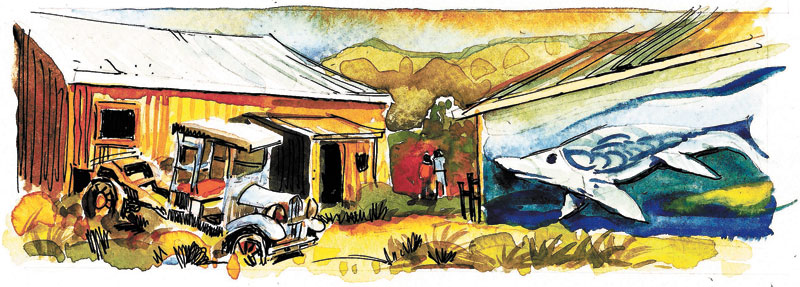Berlin-Ichthyosaur State Park blends ghost town, fossil beds
Unique among the scores of ghost towns scattered across Nevada, old Berlin in Central Nevada remains the only former boomtown to receive protection as a state park. Created by the Nevada Legislature in 1957, Berlin-Ichthyosaur State Park couples the 1890s ghost town with a nearby fossil bed of huge marine reptiles discovered in the 1920s.
Listings of the ghost town on the National Register of Historic Places and the fossil beds as a Registered National Landmark underscore the importance of the resources protected in this remote 1,540-acre park. A roofed enclosure open to guided tours preserves the main fossil bed excavation. The ghost town lies as it was when it died in 1911, maintained in a state of "arrested decay," its weathered buildings open to self-guided tours.
Berlin-Icthyosaur lies in the foothills of the Shosone Range 23 miles east of Gabbs about 340 miles from Las Vegas. To reach it, head northwest on US 95 toward Hawthorne. At a junction near Luning, take Highway 361 thorough Gabbs to the turnoff onto Highway 844. Stop to read any park notices posted at this turnoff.
The paved route climbs to a mountain pass, then down across a wide valley toward the Shoshone Mountains. Although the park remains open all year, winter storms occasionally close the access highway. Situated between 6,500 and 7,000 feet elevation, Berlin-Icthyosaur often gets seasonal snow. Even in summer, visitors find they need jackets on overcast days or after sundown.
Expect to pay a nominal park entrance fee of $4. Visitors picnic free of charge in the day-use picnic area near the fossil shelter, which includes shaded tables, grills, centralized water, restrooms and trash cans. Visitors pay $12 per night for use of sites in the 14-unit campground. Individual sites placed well apart contain sheltered tables, grills and fire rings. Water is not available in winter. Some sites accommodate recreational vehicles up to 24 feet in length. Please keep pets leashed.
As visitors explore the park, they glean details of the history of Berlin and nearby Union from informational signs. Peering through the windows of homes and businesses, they step back in time. People left behind personal effects, goods, tools, and office records when they vacated nearly a century ago.
The popular Diana Mine tour is no longer available because of safety concerns.
Mining in the area started with silver discoveries in Union Canyon in 1863, spawning a spattering of camps, including Union, Ione and Grantsville. Berlin resulted from 1869 discoveries and claims finally developed in 1898. When mining started there, miners first occupied abandoned buildings in Union, by then a ghost camp. During its heyday in the first years following the turn of the 20th century, Berlin was home to 200-250 people. In addition to mill and mine buildings, Berlin had a grid of streets with residences, a post office, an infirmary, a general store, a union hall, a barn, a stage station, corrals, a busy prostitute and a sad little cemetery.
Connecting the campground and the fossil shelter, a nature trail provides a stroll through the woods. Signs provide information and viewing windows overlook the excavation site at the shelter for those who miss one of the guided tours. Fossil shelter tours run from mid-March through mid-November, weekends only from March to Memorial Day and Labor Day to November. During the summer, weekend tours are offered at 10 a.m., 12 p.m., and 2 p.m. Weekday tours assemble at 10 a.m. and 2 p.m. Tours cost $3 for adults and $2 for children.
A large bas-relief at the fossil shelter shows visitors what the whale-sized ichthyosaurs looked like as they hunted in ancient seas. Of all the fossil discoveries of the widespread creatures, those at Berlin are among the largest, up to 50 feet in length. Several periods of scientific excavations revealed 40 of the prehistoric creatures throughout the park. Work continues sporadically. At the shelter, several skeletons lie on top of each other, as if washed up on the shore after a die-off. The ichthyosaur became Nevada's official state fossil in 1984.
Margo Bartlett Pesek's column appears on Sundays.






















